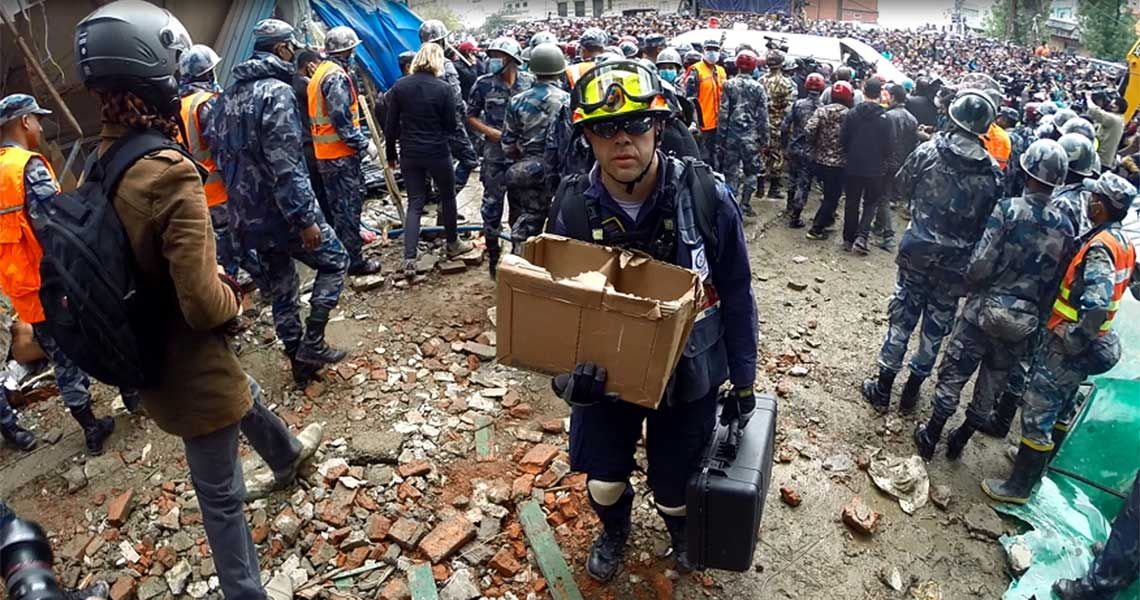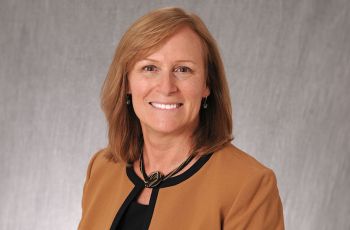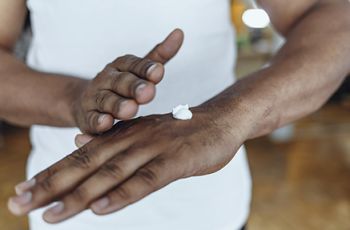His name was Pemba Tamang. He was 15 years old, a motorcycle rider buzzing out of a hotel parking garage when the 7.8-magnitude earthquake struck Kathmandu, Nepal, on Saturday, April 25. The multi-story building pancaked on top of Tamang, but his fallen motorbike created a small cache of space, protecting him from the crushing weight of steel and concrete.
As Bruno Petinaux, M.D., RESD ’02, associate professor of emergency medicine at the GW School of Medicine and Health Sciences (SMHS) and a 12-year veteran of the Fairfax County Urban Search and Rescue team, recalls, “He was entombed in the building, with no injuries at all — he was very fortunate — but he was trapped and couldn’t get out. He couldn’t even move too much.”
On the morning of Tamang’s fifth day under the rubble, a nearby rescuer heard his calls. A few hours later, a crew of Nepali and international responders — including Petinaux and the members of his rescue team — pulled Tamang into the light of day.
“What stands out to me,” says Petinaux, “is that he reported talking with two other children who were also entombed and trapped during that time period. He was very adamant about having spoken to those children, a 3-year-old and a 12-year-old. The day he was found, he said that morning, the children stopped talking to him.”
After extensive searching, Petinaux says, they concluded that the children had perished.
The tale of Tamang and his trapped companions, a mixture of miracle and tragedy, typifies disaster rescues. While no two are the same, Petinaux and his colleague, Anthony Macintyre, M.D., RESD ’96, professor of emergency medicine at SMHS and Fairfax County Urban Search and Rescue medical director, tackle each one with the same amount of grit and determination.
The two are longtime search and rescue team members and have deployed domestically with the Federal Emergency Management Agency and abroad with the United States Agency for International Development (USAID). Macintyre’s first deployment was to the bombing site of the Murrah Federal Building in Oklahoma City, Oklahoma, in 1995; more recently, he and Petinaux traveled to Port au Prince, Haiti, in 2010; and this past April, they spent more than two weeks in Kathmandu. Their role, Petinaux says, is to “use our skill in emergency medicine and confined-space medicine to contribute to the team and the effort of all.”
Treatment in rubble
As the doctors explain, disasters such as earthquakes or bombings, where people become trapped or pinned, can present unique medical challenges. The first challenge, Petinaux says, is access.
“I’m an emergency medicine physician; all my patients are on a gurney,” he says. “I can access any part of their body very easily. But if I now entomb you in a collapsed structure, the first thing that I might find is your foot. So, the only thing that I might be looking at for hours on end is providing health care to you, having access only to your foot.”
On top of limited access to the body, team members like Petinaux and Macintyre are faced with the logistical challenges of getting through the materials — wood, concrete, steel — that surround a patient. The core of the rescue team, however, includes people specially trained to evaluate collapsed structures and find methods of access. They “do the actual cutting and lifting,” Petinaux says. “Then you have the medical personnel who try and sustain that person’s life.”
Sustainability is dictated by the second and third challenges: the nature of the injuries and how quickly Petinaux and Macintyre can provide care.
“Some of these extrications can take many hours, so delivering the care as soon as we can, initiating the care as soon as we can, is vital,” Macintyre explains. “Both physicians and medics are trained to crawl into these various situations to initiate care.”
The injuries themselves span a spectrum of minor cuts and bruises to major life-threatening trauma, such as a pinned arm or leg, which can lead to “crush syndrome.”
“Anytime you take a large amount of muscle mass and put pressure on it for a sustained period, you begin to kill that muscle mass,” Macintyre says. “Then when you remove that pressure, it can release toxins into the blood stream that can cause you to get sick very quickly — drop your blood pressure, cardiac arrhythmia, things of that nature.”
Pressure can come in the form of an exterior object — a piece of furniture, a slab of concrete — or in a patient’s own body weight, particularly if he or she is on a hard surface. Again, time, Macintyre says, is crucial.
“The clock starts ticking the moment you release that pressure, whether you’re releasing pressure on the body or releasing the body’s pressure on a hard surface, and [patients] can get sick very quickly,” he says. “That also promotes the need to have pretty high-level, sophisticated medical care as soon as possible.”
The aftermath
While Tamang’s rescue was a feat for the mass of foreign and local rescuers in Kathmandu, the work of Petinaux, Macintyre, and the Fairfax County Urban Search and Rescue team, known as USA-1 on their deployment, continued. With help from USA-2, a Los Angeles-based USAID-deployed sister team, USA-1, comprising almost five dozen people and six dogs, sought out survivors in what Petinaux describes as “spaces that offer life opportunities.”
“When you think of things like basements, you may have some spaces that remain intact,” Petinaux says.” You may have other areas where you may have food for sources — for example, a kitchen — or a bathtub or a refrigerator. Those are the spaces that we look for in such buildings and hopefully are able to find some of the victims.”
After 17 days in Kathmandu, Petinaux returned to Washington, D.C. Four hours after he left, a 7.4-magnitude aftershock hit.
“A lot of the stories you hear, I can verify; it’s very hard to walk, let alone run when a building is shaking that violently,” says Macintyre, who was several floors inside a structure when the aftershock struck. “Of course, when that happened, the team spun back up.”
Macintyre, who had been working in a strategic capacity, turned operational, and USA-1 joined forces with the U.S. Department of Defense Joint Task Force 505 unit to fly teams into the hard-hit mountains. Victims were flown back down to the airport, where Macintyre and other medical team members assisted with a “fairly robust triage-stabilization unit” established by the U.S. Marines.
“As casualties were flown in, they were stabilized and triaged and moved on from there,” Macintyre explains.
While the time in Kathmandu was intensely focused on unearthing survivors and saving lives, for Petinaux, he was “just one piece of the puzzle.”
“I’m a team member of a multi-disciplinary task force that does this very unique mission,” he says.
For his part, Macintyre was struck by the Nepalese affected by the earthquakes.
“I think one of the reasons that Nepal holds such a special place in many different countries’ hearts and minds is the people there are just uniformly very pleasant and kind,” Macintyre says. “I’m not sure of too many countries that are like that where you can feel very welcomed by just about all different levels of society.”



